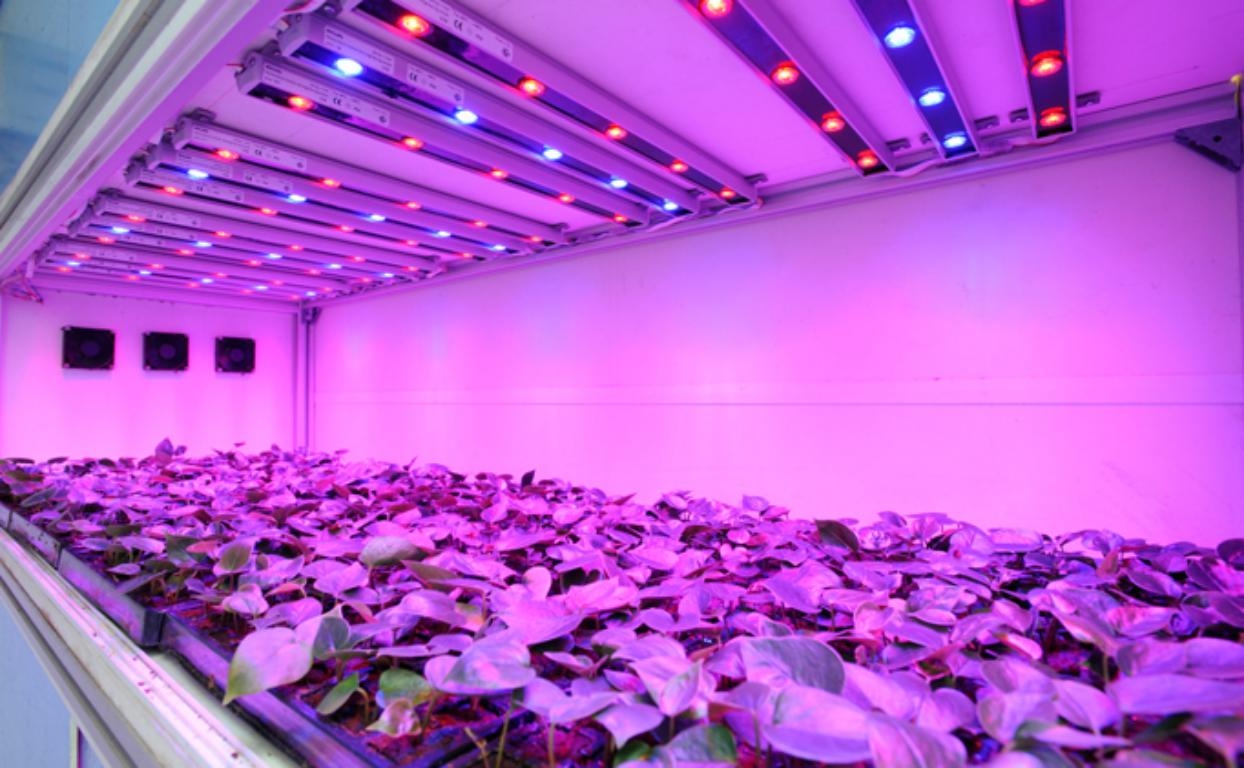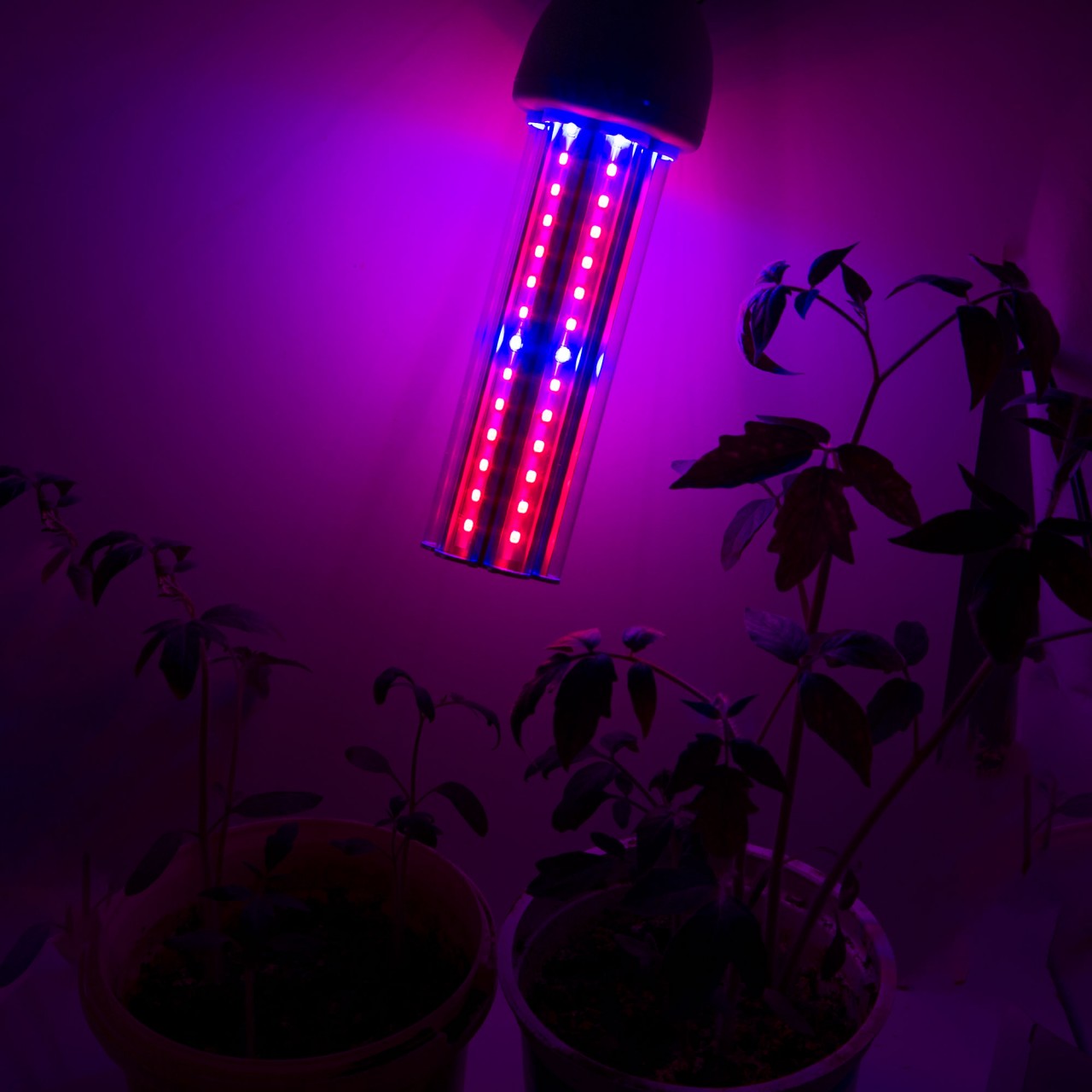The issue of landscaping an apartment is simple in itself. There are more than 1000 types of indoor plants for sale. On this occasion, many books, articles in magazines, instructions, etc. have been published. But almost all of them consider finding indoor plants in natural light, even if in partial shade.
Content
Why do plants need good lighting?
Plants require lighting for photosynthesis, after which special substances appear that are for them energy and base material... First of all, the formation of this substance will depend on the volume and quality of the illumination energy that the leaves absorb. But chlorophyll, which directly transforms the luminous flux into organic compounds, has pronounced absorption maxima in the blue and red ranges of the spectrum. At the same time, it rather weakly absorbs the yellow and orange spectrum and does not absorb infrared and green rays at all.
In addition to chlorophyll, pigments such as carotenoids take part in the absorption of light. As a rule, they are invisible in the leaves due to the presence of chlorophyll, but in autumn, when it is destroyed, carotenoids give the foliage an orange and yellow color. In the process of photosynthesis, they are of no small importance, since they absorb rays of light in the blue and violet spectrum, these colors prevail on cloudy days.
What does a houseplant need?
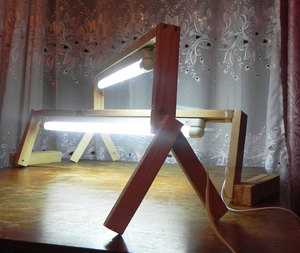 The need of plants for lighting largely depends on the temperature in the room, the warmer the room, the more light the plant needs. Thus, plants in the winter have the worst in a poorly heated and poorly illuminated room.
The need of plants for lighting largely depends on the temperature in the room, the warmer the room, the more light the plant needs. Thus, plants in the winter have the worst in a poorly heated and poorly illuminated room.
Light mode... The length of daylight hours has an important role in the life of any plants. For equatorial flowers, which are accustomed to almost constant natural light at 12 o'clock, most likely they will not like our geographical location, when the minimum daylight hours lasts up to 7 hours, and the maximum day is more than 15 hours.
Supplementary lighting and artificial lighting for plants
First, let us determine when it really is additional lighting of plants is required:
- During the keeping of plants in winter and autumn at temperatures above 22 ° C in regions with very short daylight hours.
- When keeping plants on windowsills with direct sunlight less than 3.5 hours.
- During the maintenance of seedlings of plants in winter and autumn in regions where cloudy weather prevails.
In other cases, installing additional lighting is simply unjustified and, to some extent, will be a useless waste of money and effort.
During supplementary lighting of plants, it is necessary take into account such factors:
 For seedlings, for better growth, lighting can be arranged around the clock. When you grow indoor flowers from seeds, then immediately after germination, bright light is desirable for young shoots around the clock. Daylight hours are gradually reduced, first to 15, then to 11-12 hours.
For seedlings, for better growth, lighting can be arranged around the clock. When you grow indoor flowers from seeds, then immediately after germination, bright light is desirable for young shoots around the clock. Daylight hours are gradually reduced, first to 15, then to 11-12 hours.- It has been experimentally proven that for the minimum activity of photosynthesis of an indoor flower, a light level of 120 lux is enough, but for better absorption of moisture, carbon dioxide, and other minerals, a level of at least 1500 lux is required.
- Daylight hours are needed no more than 15 hours for already rooted flowers. A very long daylight hours disrupt the formation of both buds and, in general, is detrimental to the plant. From birth, all flowers are “programmed” for specific daylight hours. A popular misconception is that the longer the light shines on the plants, the better. But in reality this is not true - depriving plants of the "night" is analogous to taking away our sleep. It is absolutely unacceptable not to observe the daily cycle, not knowing the peculiarities of plant photosynthesis by constant illumination.
- For the formation of buds and flowering of plants, a warm room and good lighting are required for 12-13 hours. It has been proven that buds appear best after a short rest of the plant during cloudy weather with low temperatures and low light. The chemical processes that create blooms take place at night. To complete the preparation for flower formation, the minimum dark time must be maintained continuously for about 9 hours.
- The choice of lighting in winter will depend on the temperature characteristics of the plant. Heat-loving flowers hibernate with a slight decrease in temperature and light. At a winter temperature of less than 10C on a lighted windowsill, additional lighting is not required.
- Plants have such a property as phototropism - this is a reaction to the direction of illumination. Artificial lighting must hit the flowers in the same way as natural, namely from above, in this case, the colors will not need to spend energy on turning the leaves in order to get the maximum amount of light.
Artificial lighting for indoor plants
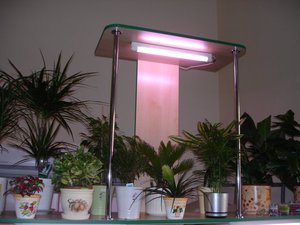 It is prohibited to use classic incandescent lamps alone: there is no violet and blue in their spectrum, and infrared irradiation creates stretching of flowers, their strong heating, drying of leaves and uselessly consume electricity.
It is prohibited to use classic incandescent lamps alone: there is no violet and blue in their spectrum, and infrared irradiation creates stretching of flowers, their strong heating, drying of leaves and uselessly consume electricity.
Such advertised special neodymium incandescent bulbs today do not show significant improvement. These include Paulmann Phyto-lamps, OSRAM lamps, etc. Despite their high illumination due to reflective deposition and a small angle of light, their spectral characteristics practically do not differ from ordinary incandescent lamps.
A slightly better effect can be achieved with halogen bulbs. But, despite the more positive spectrum composition and increased light output, this type of lamp is hardly optimal, since the filament generates a large release of thermal energy.
You can maintain an attractive appearance of flowers and grow seedlings using lighting white fluorescent lamps, they create cold light (their spectrum is as close as possible to the solar spectrum). Since these lamps are not very powerful, several of them are installed simultaneously in special reflectors that enhance the flow of light and prevent flickering lighting from entering the room.
As a rule, their disadvantages are reduced to the increased diffusion of the light flux (many lamps are required for sufficient light) and to the quality of the lighting created. Fluorescent lamps have a lot of blue in their spectrum, so they only need to be installed in combination with others.
The purpose of fluorescent lamps is to illuminate shelves with flowers, supplementary lighting of plants on the window. It is almost impossible to fully grow flowers that are very demanding on lighting under fluorescent lamps.
Phyto-fluorescent lamps in the form of tubes are actually effective in the process of photosynthesis, are economical, create uniform light on the surface and heat up slightly during operation, this makes it possible to install them close to flowers.But their pinkish illumination is unnatural for people, irritates mucous membranes and significantly changes the visual perception of decorativeness of flowers.
Phyto-lamps with several peaks of light emission in the blue and red spectrum, specially made for flowers, they are also perfect for young shoots and growing seedlings. You can choose phytolamps with more natural lighting, but the efficiency of these lamps is slightly lower, due to the radiation in the unused spectrum by plants - green, which, at the same time, can be compensated by adding powerful lamps.
Sodium, metal halogen and mercury lamps - these are the so-called high-pressure gas-discharge lamps. Their main purpose is to create a powerful luminous flux. So, they are best suited for illuminating greenhouses, winter gardens, large single flowers, plants that are very demanding on light. They speak with caution about the possibility of installing these lamps in apartments - such lamps are quite expensive, use a large amount of electricity and heat up significantly, many work in the ultraviolet spectrum, which is dangerous for vision.
High light photodiode bulbs are also heavily advertised today. With all the advantages, these lamps have a significant disadvantage (apart from the price) - low power.
Height and options for installing lamps above indoor flowers
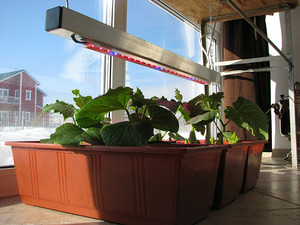 The best position of the lamps is achieved with the condition that the lighting will fall on the flowers from above.
The best position of the lamps is achieved with the condition that the lighting will fall on the flowers from above.
Highly high lamps in order to illuminate the maximum number of plants, as a result, nothing is highlighted, since the illumination decreases in proportion to the distance, for example, by setting the illumination height from 25 cm to a meter, the illumination will be reduced by 30 times. The optimum height for light-loving colors is a lamp position (fluorescent) of approximately 17-22 cm.
The most economical option is to make the direction of the light flow perpendicular to the plant, that is, install the lamp directly above the flowers, and equip the light source with a reflector. You can purchase pre-made reflectors from aquarium stores. With the help of a reflector, you can remove the feeling of discomfort if the light falls into the eyes, but the most important thing is to direct the main part of the light flow, which is often wasted, with almost no loss. Phyto-lamps have a full spectrum of rays required only by colors and therefore create light that irritates human vision. For this reason, phyto-lamps especially need reflectors.
It is advisable to hang a light bulb over the flowers: when illuminated from the side, the plants grow, stretching towards the light source. If the flowers are illuminated only by artificial lighting, then the lamps need to work at least 12 hours daily... If artificial light is used as an additional light, for example, in winter, then 4-6 hours is enough.
The height of the lamps installation is best made adjustable, so that when burns are detected on the flowers, you can change the lamp height. Tall stems and a pale color indicate that the light source is quite high. The smallest distance of a flower to an incandescent light bulb is 35cm, to a luminescent light 7cm, to a sodium light - half a meter.
How to calculate the number of fluorescent lamps?
Backlight power calculation and the choice of the type of light bulbs will completely depend on the lighting needs of indoor flowers. All flowers, according to the degree of need for illumination, can be divided into:
- shade-tolerant;
- loving moderate lighting - tropical plants;
- light-loving - plants whose homeland is large solar spaces.
Lighting power must be selected in proportion: 1 dm. sq. flower area should be:
- more than 2.5 W for light-loving;
- 1.5-2.5 W - for those who love moderate backlighting;
- 0.50-1.5 W - for shade-tolerant.
According to the degree of illumination, 1 Watt of power of a fluorescent lamp generates 70 lumens, an incandescent lamp - 4 times less.Taking into account this value, you can calculate the number and power of light bulbs for flowers. For example, the size of the windowsill where the plants are located is 100 dm. sq. Thus, the following total lamp wattage will be needed:
- 2.5W x 100dm. sq. = 250W.
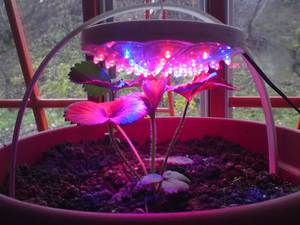 This area will need approximately 2-3 bulbs with a power of 70 W... It must be said that this calculation is approximate and is considered only a guideline in choosing their number. It is desirable to use powerful and oblong lamps, since they have a high luminous efficiency. In other words, two 34W lamps are better than four 17W lamps.
This area will need approximately 2-3 bulbs with a power of 70 W... It must be said that this calculation is approximate and is considered only a guideline in choosing their number. It is desirable to use powerful and oblong lamps, since they have a high luminous efficiency. In other words, two 34W lamps are better than four 17W lamps.
Summing up, it must be said that the duration of artificial lighting will depend directly on natural lighting. As a rule, it is a couple of sutra hours and a few at night. That is, the lamps will be on in the morning, until the time you need to go to work, and in the evening until the time before bed.
But, in general, this time must be about 5-7 hours... In cloudy weather, up to 10 hours. If the day is sunny, 4 hours are enough. In addition, it has been proven that the backlight does not show a positive effect when it is irregular, since turning on the lamps only "when you remember" will only harm indoor flowers by knocking their biorhythms.
